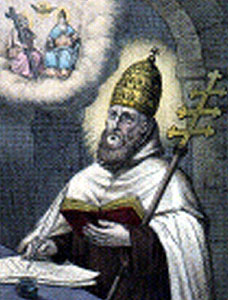|

260 AD to 268
AD

Date of birth unknown; d. 26 or 27 December, 268. During the
pontificate of Pope Stephen (254-57) Dionysius appears as a
presbyter of the Roman Church and as such took part in the
controversy concerning the validity of heretical baptism (see
BAPTISM under sub-title Rebaptism). This caused Bishop
Dionysius of Alexandria to write him a letter on baptism in which he
is described as an excellent and learned man (Eusebius, Hist eccl.
VII, vii). Later, in the time of Pope Sixtus II (257-58), the same
Bishop of Alexandria addressed Dionysius a letter concerning
Lucianus (ibid., VII, ix), who this Lucianus was is not known. After
the martyrdom of Sixtus II (6 August, 258) the Roman See remained
vacant for nearly a year, as the violence of the persecution made it
impossible to elect a new head. It was not until the persecution had
begun to subside that Dionysius was raised (22 July, 259) to the
office of Bishop of Rome. Some months later the Emperor Gallienus
issued his edict of toleration, which brought the persecution to an
end and gave a legal existence to the Church (Eusebius, Hist. eccl.,
VII, xiii). Thus the Roman Church came again into possession of its
buildings for worship, its cemeteries, and other properties, and
Dionysius was able to bring its administration once more into order.
About 260 Bishop Dionysius of Alexandria wrote his letter to
Ammonius and Euphranor against Sabellianism in which he expressed
himself with inexactness as to the Logos and its relation to God the
Father (see DIONYSIUS OF ALEXANDRIA). Upon this an accusation
against him was laid before Pope Dionysius who called a synod at
Rome about 260 for the settlement of the matter. The pope issued, in
his own name and that of the council, an important doctrinal letter
in which, first, the erroneous doctrine of Sabellius was again
condemned and, then, the false opinions of those were rejected who,
like the Marcionites, in a similar manner separate the Divine
monarchy into three entirely distinct hypostases or who represent
the Son of God as a created being, while the Holy Scriptures declare
Him to have been begotten passages in the Bible, such as Deut.,
xxxii, 6, Prov., viii, 22, cannot be cited in support of false
doctrines such as these. Along with this doctrinal epistle Pope
Dionysius sent a separate letter to the Alexandrian Bishop in which
the latter was called on to explain his views. This Dionysius of
Alexandria did in his "Apologia" (Athanasius, De sententia Dionysii,
V, xiii, De decretis Nicaenae synodi, xxvi). According to the
ancient practice of the Roman Church Dionysius also extended his
care to the faithful of distant lands. When the Christians of
Cappadocia were in great distress from the marauding incursions of
the Goths, the pope addressed a consolatory letter to the Church of
Caesarea and sent a large sum of money by messengers for the
redemption of enslaved Christians (Basilius, Epist. lxx, ed.
Garnier). The great synod of Antioch which deposed Paul of Samosata
sent a circular letter to Pope Dionysius and Bishop Maximus of
Alexandria concerning its proceedings (Eusebius, Hist. eccl., VII,
xxx). After death the body of Dionysius was buried in the papal
crypt in the catacomb of Callistus.
Return
Home |